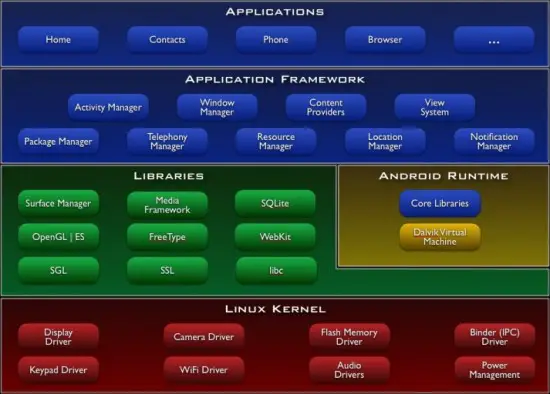Typically when you talk about going bigger, badder and faster you’re also talking about draining substantial battery life. Just the opposite in the case of the Dalvik Turbo virtual machine which was announced yesterday by OHA member Myriad Group AG:
Dalvik Turbo increases application execution speed by up to three times ‐ allowing OEMs and operators to bring smoother delivery and more complex applications to Android phones, while also providing substantial battery life improvements when running resource intensive tasks. It also enables developers to take full advantage of Android, allowing them to create games boasting advanced graphics and complex models while retaining full compatibility with existing software.
I know, I know – a bunch of you are wondering what the heck a Dalvik engine is and what its used for, right? Take a look at the Android OS architecture and just be content with realizing this stuff is probably over your head:
Well right now all Android Phones use a standard Dalvik engine, which is a virtual machine that applications/activities pass through, so an improvement here would be an improvement across the board. And a 3x speed improvement? All while saving battery life?
This could be huge and we’ll find out just how huge this upcoming week as the company promises to demonstrate Dalvik Turbo in action at Mobile World Congress February 15th to 18th.











This will hopefully make all of those 528MHz Androids usable… and phones like the Motorola Droid faster without having to overclock.
AndroidsOfTara. Overclocking has been made extremely simple so has rooting the phone. Google it.
Are there any other Mobile OS systems that use this?
I wish that Google would buy a license for all android phones, or manufacturers pay the license fee for the phone. Alternately, would there be a way to sell it in the market place? I would gladly pay $5 for it, if the claims are true.
@Derrick, yes it is easy and simple but some people don’t like to do it, this would be an official release so win win for EVERYONE
How would this new engine be delivered? Will it have to be implemented in Android, meaning you would have to wait for your phone to be updated to the newest version of Android? And we all know how long that takes. On the other hand, would it come out as a stand alone update, so that all phones no matter what version of Android you are running can get it?
I think because it’s such an in-deep element of the operating system that it would probably come in a future iteration of Android and NOT as a quick wipeless OTA on any Android version.
I want a shiny red button to turn this on and off :D
@Derrick
not to mention overclocking hurts battery life while this will instead improve it
Although it is an OK improvement, it doesn’t seem to be where it should have been in the first place.
Take a look:
http://groups.google.com/group/android-ndk/browse_thread/thread/54455032627f732e?pli=1
It seems to me that this should be able to be done as part of an update. If you can change the kernel in an update then certainly you can change the app VM. There would only be a problem if it could not run the bytecode from the previous version. Otherwise this is like upgrading your Java VM on your desktop (if anyone still has one lol.) I just hope they plan to pass this along to all the older phones. A 3x speed gain would be huge and would really deal a final blow to the iPhone. Imagine your G1 running as smoothly as an iPhone. And then imagine the juice hungry apps that could be written that would have just been two slow at the time.
fake
Why is everyone talking about using this *instead* of overclocking? If you overclock on top of this, your phone will go back in time and actually finish running the app before you even start it!!
@Phil
The press release mentions that it works with all preexisting applications.
“Why is everyone talking about using this *instead* of overclocking? If you overclock on top of this, your phone will go back in time and actually finish running the app before you even start it!!”
Which is exactly how I’m posting this from my Android 3.2 NexusFour. Great phone by the way. Has the iPad been announced yet? If not, short sell Apple stock. Just a tip from future me.
Unfortunately, it seems like wasted effort once they get the JIT compiler running.
It’s only wasted if it doesn’t come out until after the JIT compiler is out.
how are they planning on using this?
is it gonna be possible to update? or is it only gonna be included on future phones?
@David the only smart comment here so far.
Google are already working on a Dalvik JIT, so would be interesting to see how turbo Dalvik stacks up against the Google JIT Dalvik.